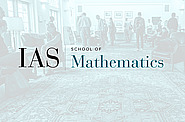Seminars Sorted by Series
Computer Science/Discrete Mathematics Seminar II
Nov
30
2004
Computer Science/Discrete Mathematics Seminar II
On Random Bernoulli Matrices: Singularity and Determinant
10:30am|S-101
Dec
07
2004
Computer Science/Discrete Mathematics Seminar II
Variance/Entropy Decomposition Techniques for Proving Fast Mixing of the Glauber Dynamics
10:30am|S-101
Dec
14
2004
Computer Science/Discrete Mathematics Seminar II
Variance/Entropy Decomposition Techniques for Proving Fast Mixing of the Glauber Dynamics
10:30am|S-101
Jan
18
2005
Computer Science/Discrete Mathematics Seminar II
On Lattices, Learning with Errors, Random Linear Codes, and Cryptography
10:30am|S-101
Jan
25
2005
Feb
01
2005
Computer Science/Discrete Mathematics Seminar II
Geometric symmetrizations in high dimension
10:30am|S-101
Feb
08
2005
Feb
15
2005
Computer Science/Discrete Mathematics Seminar II
Fixed Point Properties of Random Groups
10:30am|S-101
Feb
22
2005
Computer Science/Discrete Mathematics Seminar II
Quadratic Forms on Graphs
Konstantin Makarychev
10:30am|S-101
Mar
01
2005
Computer Science/Discrete Mathematics Seminar II
Pseudorandom Walks in Biregular Graphs and the RL vs. L. Problem
10:30am|S-101
Mar
08
2005
Mar
15
2005
Mar
22
2005
Computer Science/Discrete Mathematics Seminar II
1 Dimensional Diffusion Limited Aggregation (DLA)
Gideon Amir
10:30am|S-101
Mar
29
2005
Computer Science/Discrete Mathematics Seminar II
Controlled Linear Programming and Linear Complementarity for Some Infinite Games in NP $\cap$ coNP
Sergei Vorobyov
10:30am|S-101
Apr
05
2005
Apr
12
2005
Computer Science/Discrete Mathematics Seminar II
Cuts, Quadratic Programs and in Between
Muli Safra
10:30am|S-101
Apr
19
2005
Computer Science/Discrete Mathematics Seminar II
Additive Approximation for Edge-Deletion Problems
10:30am|S-101
Apr
26
2005
Computer Science/Discrete Mathematics Seminar II
Lower Bounds for the Noisy Broadcast Problem
Navin Goyal
10:30am|S-101
May
03
2005
Computer Science/Discrete Mathematics Seminar II
Extremal Erodos-Szekeres Permutations and Square Young Tableaux
Dan Romik
10:30am|S-101
May
31
2005
Computer Science/Discrete Mathematics Seminar II
Approximation Algorithms for Unique Games
11:30am|S-101
Sep
27
2005
Computer Science/Discrete Mathematics Seminar II
Property Tau and the Product Replacement Algorithm
Alex Lubotzky
10:30am|S-101
Oct
11
2005
Nov
01
2005
Computer Science/Discrete Mathematics Seminar II
Expander Graphs on the Symmetric Groups
10:30am|S-101
Nov
08
2005
Computer Science/Discrete Mathematics Seminar II
Expander Graphs on the Symmetric Groups, Part II
10:30am|S-101
Nov
22
2005
Computer Science/Discrete Mathematics Seminar II
Euclidean Embeddings of Finite Metric Spaces: Distortion and Expansion
10:30am|S-101
Nov
29
2005
Computer Science/Discrete Mathematics Seminar II
Szemeredi's Regularity Lemma in Analysis
10:30am|S-101
Dec
06
2005
Computer Science/Discrete Mathematics Seminar II
Coding Theory: Survey of Recent Progress and Open Questions
Madhu Sudan
10:30am|S-101
Dec
13
2005
Computer Science/Discrete Mathematics Seminar II
Dependent Random Choice and Extremal Problems
Benny Sudakov
10:30am|S-101
Jan
17
2006
Computer Science/Discrete Mathematics Seminar II
Szemeredi's Regularity Lemma and Compactness
10:30am|S-101
Jan
24
2006
Jan
31
2006
Feb
14
2006
Computer Science/Discrete Mathematics Seminar II
Quantum Computing and Finite Permutation Groups
Aner Shalev
10:30am|S-101
Feb
28
2006
Computer Science/Discrete Mathematics Seminar II
Independent Transversals in Locally Sparse Graphs
Po-Shen Loh
10:30am|S-101
Mar
07
2006
Computer Science/Discrete Mathematics Seminar II
Strong Approximation in Random Towers of Graphs
10:30am|S-101
Mar
14
2006
Computer Science/Discrete Mathematics Seminar II
Group Theoretic Algorithms For Fast matrix Multiplication
Balazs Szedgedy
10:30am|S-101
Mar
28
2006
Computer Science/Discrete Mathematics Seminar II
The Grothendieck Constant of an Expander
10:30am|S-101
Apr
04
2006
Apr
11
2006
Computer Science/Discrete Mathematics Seminar II
New Techniques in Online Game Playing
Elad Hazan
10:30am|S-101
Apr
18
2006
Apr
25
2006
Computer Science/Discrete Mathematics Seminar II
<a href="http://dimacs.rutgers.edu/Workshops/Spencer/">Click here for details about DIMACS Workshop</a>
No Seminar Due to DIMACS Workshop
10:30am
May
02
2006
Computer Science/Discrete Mathematics Seminar II
On the Minimal Density of Triangles in Graphs
10:30am|S-101
May
09
2006
Computer Science/Discrete Mathematics Seminar II
On the Minimal Density of Triangles in Graphs (continued)
10:30am|S-101
May
16
2006
Computer Science/Discrete Mathematics Seminar II
Randomness Reduction in Some Results of Asympotic Geometric Analysis
Shiri Artstein
10:30am|Dilworth Room
Sep
19
2006
Computer Science/Discrete Mathematics Seminar II
The Sum-Product Theorem and Applications
10:30am|S-101
Sep
26
2006
Computer Science/Discrete Mathematics Seminar II
Sum-Product Theorem in Finite Fields (Continued)
10:30am|S-101
Oct
03
2006
Computer Science/Discrete Mathematics Seminar II
A Randomized Polynomial-Time Simplex Algorithm for Linear Programming
10:30am|S-101
